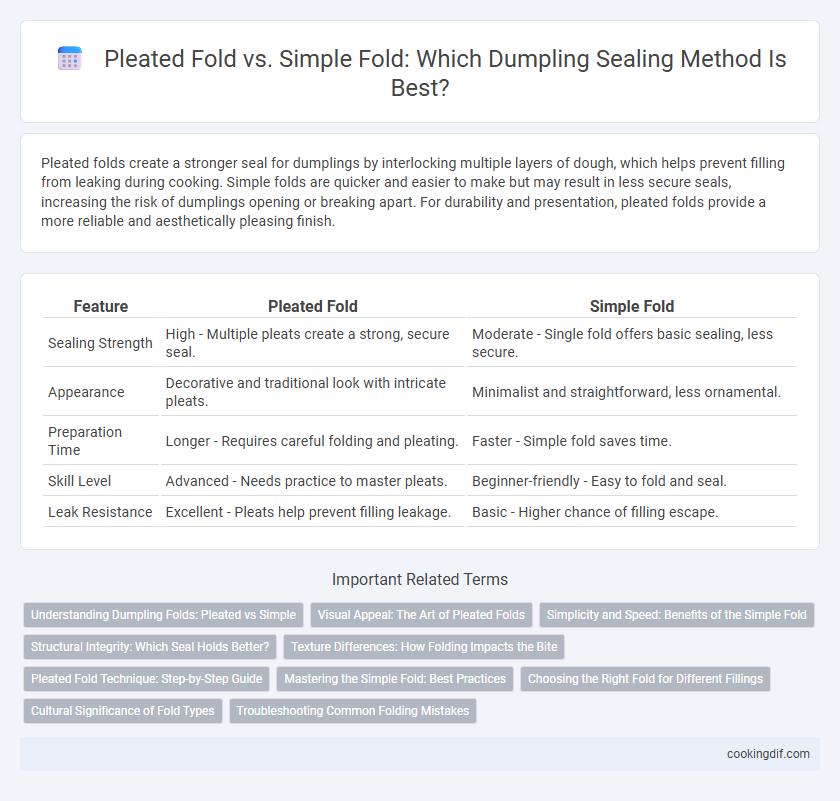Pleated folds create a stronger seal for dumplings by interlocking multiple layers of dough, which helps prevent filling from leaking during cooking. Simple folds are quicker and easier to make but may result in less secure seals, increasing the risk of dumplings opening or breaking apart. For durability and presentation, pleated folds provide a more reliable and aesthetically pleasing finish.
Table of Comparison
| Feature | Pleated Fold | Simple Fold |
|---|---|---|
| Sealing Strength | High - Multiple pleats create a strong, secure seal. | Moderate - Single fold offers basic sealing, less secure. |
| Appearance | Decorative and traditional look with intricate pleats. | Minimalist and straightforward, less ornamental. |
| Preparation Time | Longer - Requires careful folding and pleating. | Faster - Simple fold saves time. |
| Skill Level | Advanced - Needs practice to master pleats. | Beginner-friendly - Easy to fold and seal. |
| Leak Resistance | Excellent - Pleats help prevent filling leakage. | Basic - Higher chance of filling escape. |
Understanding Dumpling Folds: Pleated vs Simple
Pleated folds create intricate ridges by pinching the dough multiple times, enhancing the dumpling's structural integrity and aesthetic appeal, while simple folds involve a single, straightforward seal, offering ease and speed in preparation. The pleated method ensures a tighter seal, reducing the risk of filling leakage during cooking, making it ideal for complex fillings and steaming. Simple folds cater to quick assembly and are best suited for pan-frying or boiling, where a less robust seal suffices.
Visual Appeal: The Art of Pleated Folds
Pleated folds create an intricate, scalloped edge that enhances the visual appeal of dumplings, making them look more artisanal and inviting. Simple folds provide a clean, minimalistic appearance but lack the decorative texture that pleated folds offer. The artful pleating technique not only showcases craftsmanship but also signals a premium, hand-made quality to diners.
Simplicity and Speed: Benefits of the Simple Fold
The simple fold technique for dumpling sealing offers unmatched simplicity and speed, reducing preparation time significantly compared to pleated folds. Without the need for intricate folds, this method allows for rapid assembly while maintaining a secure seal that prevents filling leakage during cooking. Ideal for both home cooks and professionals, the simple fold streamlines dumpling production without compromising quality.
Structural Integrity: Which Seal Holds Better?
Pleated folds provide enhanced structural integrity for dumplings by creating multiple overlapping layers that resist opening during cooking, ensuring a secure seal. Simple folds, while quicker to make, often lack the reinforced grip of pleated edges, increasing the risk of filling leakage and breakage. Culinary experts recommend pleated folds for dumplings that require steaming or boiling, as this technique maintains shape and prevents tearing under heat and moisture.
Texture Differences: How Folding Impacts the Bite
Pleated folds create a thicker edge that crisps more evenly during cooking, offering a satisfying contrast between the chewy dough and tender filling. Simple folds result in a thinner, softer seam that emphasizes the dumpling's interior texture without added crunch. The choice between pleated and simple folds significantly affects the mouthfeel, enhancing either a textured bite or a smooth, delicate experience.
Pleated Fold Technique: Step-by-Step Guide
The pleated fold technique for dumpling sealing involves creating multiple small, precise folds along the dumpling edge to ensure a tight, decorative seal that prevents filling leakage during cooking. Begin by placing the filling in the center of the wrapper, fold the wrapper in half, and pinch one end to form the initial seal, then make consecutive pleats along one side by folding small sections inward and pressing firmly against the opposite edge. This method enhances both the dumpling's structural integrity and visual appeal, commonly used in traditional Chinese dumplings like jiaozi and xiao long bao.
Mastering the Simple Fold: Best Practices
Mastering the simple fold for dumpling sealing involves precise edge alignment and consistent pressure to prevent leaks during cooking. Unlike pleated folds, the simple fold requires fewer steps, making it ideal for quick preparation while maintaining structural integrity. Using a light water or egg wash along the edges enhances adhesion, ensuring a secure seal that holds through steaming, boiling, or frying.
Choosing the Right Fold for Different Fillings
Pleated folds provide a secure seal ideal for juicy or loose fillings like pork or shrimp, preventing leakage during cooking. Simple folds work best with thicker, firmer fillings such as vegetable or tofu mixtures, offering a quick and sturdy closure. Selecting the right fold based on filling consistency ensures optimal texture and prevents dumpling bursting.
Cultural Significance of Fold Types
Pleated folds in dumpling sealing are deeply rooted in Chinese culinary traditions, symbolizing craftsmanship and regional identity, especially in northern China where intricate pleats reflect skill and cultural heritage. Simple folds are more prevalent in home-style cooking and represent practicality and everyday life, often seen in southern Chinese dumplings where minimalism is favored. The choice between pleated and simple folds carries cultural meaning, influencing the dumpling's appearance, texture, and symbolism in festivals and family gatherings.
Troubleshooting Common Folding Mistakes
Pleated fold dumplings often suffer from inconsistent pleat sizes, causing uneven cooking and potential filling leakage, while simple fold dumplings risk incomplete sealing due to insufficient overlap. Ensuring each pleat is uniform and pressing edges firmly prevents openings during steaming or frying. Moistening the wrapper edges slightly before sealing enhances adhesion and reduces common folding failures.
Pleated fold vs simple fold for dumpling sealing Infographic

 cookingdif.com
cookingdif.com